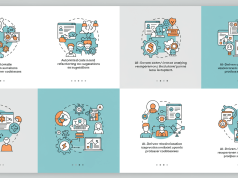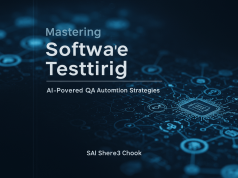In today’s fast-paced software landscape, security can no longer be an afterthought. Traditional development models that silo security from development and operations often lead to vulnerabilities and slower release cycles. DevSecOps is an approach that embeds security practices throughout the software development lifecycle, enabling teams to build, test, and deploy code with confidence. In this post, we’ll explore how to master DevSecOps in 2025 by integrating security into your CI/CD pipeline, adopting the right tools, and fostering a security-first culture.
What Is DevSecOps?

DevSecOps expands upon DevOps by treating security as everyone’s responsibility instead of a gatekeeper at the end of the process. The core idea is to automate and shift security left—meaning security checks, vulnerability scans, and compliance validations occur early and continuously. This shared responsibility model not only reduces risk but also accelerates delivery by catching issues before they reach production.
The Business Case for DevSecOps
Implementing DevSecOps delivers measurable ROI: it lowers the cost of fixing vulnerabilities (remediation is cheaper earlier in the lifecycle), improves time-to-market, and enhances customer trust. Gartner predicts that by 2025, organizations that fully embrace DevSecOps practices will reduce security defects by 90 percent and security remediation times by 75 percent.
Key Principles of DevSecOps
- Shift Left Security – Integrate security checks at every stage from code commit to deployment.
- Automation First – Use automated testing, scanning, and compliance gates to reduce manual errors.
- Continuous Feedback – Provide developers real-time insights on vulnerabilities and code quality.
- Collaboration – Break down silos between development, security, and operations teams.
- Risk-Based Prioritization – Focus on the vulnerabilities that pose the highest risk to your business.
Integrating Security into the CI/CD Pipeline
A secure CI/CD pipeline is the backbone of DevSecOps. Here’s how to weave security into each stage:
- Code Commit: Enforce pre-commit hooks for static code analysis and detect insecure coding patterns.
- Build: Integrate Software Composition Analysis (SCA) to identify vulnerable open-source dependencies.
- Test: Include dynamic application security testing (DAST) and container image scanning in your test suite.
- Deploy: Implement infrastructure as code (IaC) security checks to validate configuration and compliance before rollout.
- Monitor: Continuously watch production environments for anomalies, audit logs, and runtime threats.
Essential Tools and Technologies
No DevSecOps strategy is complete without the right toolset. Consider these categories and example solutions:
- Static Application Security Testing (SAST) – SonarQube, Checkmarx
- Software Composition Analysis (SCA) – Snyk, WhiteSource
- Dynamic Application Security Testing (DAST) – OWASP ZAP, Burp Suite
- Container & IaC Security – Aqua Security, Terraform Sentinel
- Runtime Protection – Falco, Datadog Security Monitoring
Organizational and Cultural Considerations
DevSecOps is as much about culture as it is about tools. To succeed:
- Promote Shared Ownership – Ensure security champions collaborate directly with dev and ops teams.
- Invest in Training – Provide developers with security awareness and secure coding workshops.
- Align Incentives – Reward teams for meeting security SLAs and reducing vulnerabilities.
- Implement Blameless Postmortems – Focus on process improvements rather than individual fault.
Measuring Success: KPIs and Metrics
Track progress with clear, actionable metrics:
- Mean Time to Remediate (MTTR) – How quickly security issues are fixed.
- Vulnerabilities per Release – Count of new security findings in each deployment.
- Pipeline Pass Rate – Percentage of builds passing security gates without manual intervention.
- Compliance Score – Adherence to industry standards and regulations.
Overcoming Common Challenges
Transitioning to DevSecOps can face roadblocks. Here’s how to tackle them:
- Resistance to Change – Start small with pilot projects and showcase quick wins.
- Toolchain Complexity – Consolidate overlapping tools and standardize integrations.
- Skill Gaps – Upskill existing staff and hire specialists for key security roles.
- Balancing Speed vs. Security – Use risk-based prioritization to focus on high-impact issues.
Future Trends in DevSecOps

Looking ahead to 2025 and beyond, we anticipate:
- AI-Powered Security – Automated threat detection and self-healing pipelines.
- GitOps Security – Policy-as-code and automated drift remediation.
- Zero Trust Environments – Microsegmentation and continuous authentication.
Conclusion
DevSecOps is far more than a trend; it’s a fundamental evolution in how we build and secure software in a rapidly changing digital landscape. By shifting security left, automating security controls, and fostering a culture of shared responsibility, organizations can deliver high-quality, compliant, and resilient applications faster than ever. And when you pair this approach with intelligent solutions like AI-Driven Technical Debt Management, you create a powerful synergy—proactively addressing code quality and security risks in tandem. This isn’t just about keeping up with threats; it’s about staying ahead of them, future-proofing your development process, and accelerating meaningful innovation as we move into 2025 and beyond. Start your DevSecOps journey today, and build with confidence.








